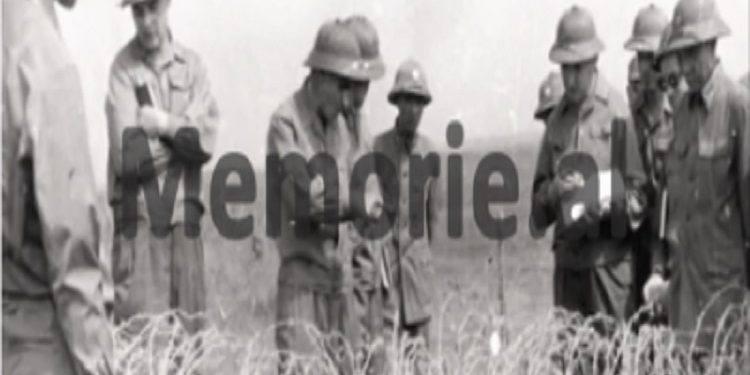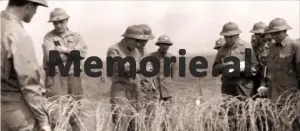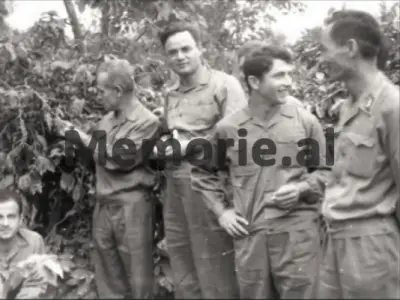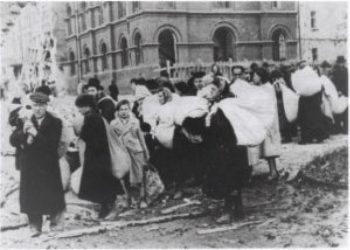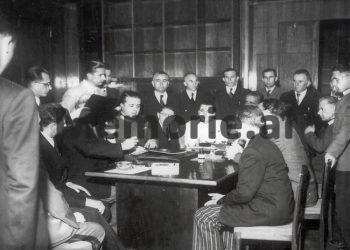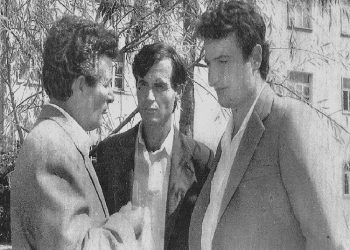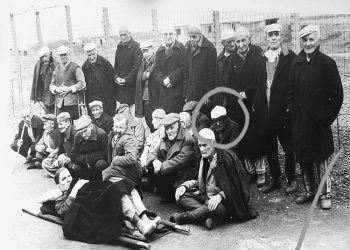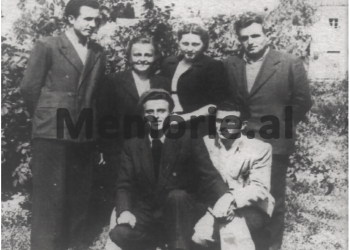By Artur Korriku
Memorie.al / At the time when Vietnam was fighting against America, it was called the Vietnamese people brother by communist propaganda. Our country aligned itself with the countries that sided with the Vietnamese, such as the Soviet Union, China, North Korea, and all the countries of Eastern Europe. In those years, the Albanian Army, based on the agreement with the Vietnamese Army, sent a group of scouts to the Asian country, which would closely watch the combat operations and participate concretely together with the Vietnamese scouts, in diversionary actions and actions. The group consisted of twelve soldiers, who were 9 scouts, 2 engineers and 1 chemist. They stayed for almost a year in the jungles of Vietnam and experienced combat actions closely, saw the horrors of war but also participated in it. Two of the Albanian soldiers were injured, in various combat actions. One of the soldiers who went to Vietnam is Novruz Zejnati, retired colonel, Doctor of Military Sciences. Now approaching eighty, Colonel Zejnati recounts the adventure of twelve Albanian explorers on Vietnamese soil.
Colonel Novruz Zejnati’s confession
Colonel Zejnati says that: “The Vietnam syndrome has harassed the American people for several decades. In many books, documentaries, feature films of Hollywood, we find and see this syndrome. Many Vietnamese and American tragedies occupied the subjects of fiction and, of course, documentary literature. I was an eyewitness of this war that has remained indelible in my memory, but also that of my friends. It has also caused physical and psychological trauma to some of them”. Vietnam was a second school for Albanian soldiers. This is how Colonel Zejnati remembers the Vietnamese adventure:
Order of service to Vietnam
“In 1966 the war in Vietnam was at its height. I was a young officer and I had just returned from the winter camp that we scouts did in Biza i Martanesh. We had spent three months away from our families in winter mountain training in camping conditions. Even before I got to know the family well, I was called to the ministry, near the Directorate of Discovery. It was the Director of Army Intelligence, Major General Andon Sheti, who received me in his office. He was a serious, knowledgeable soldier and the years of service abroad had made him quite sober and showed a cultured behavior. I have called you to thank you on behalf of the Intelligence Directorate, for the report you have prepared and the work you have done with the Intelligence officers of your unit in Biza i Martanesh. We, as the Director, have assigned you, as well as some intelligence officers, to go for experience in the Vietnam War’, he continued. As required by the military duty and oath, I answered: “as you order”, but the surprise was great and so was the shyness of the unknown that awaited us, in the place where there was fierce fighting and where the most modern weapons of the time were used. The plan was that we, the group of 12 soldiers, would first train intensively for three months at Dragot Tepelena, with a program applied by Vietnamese scouts.
The next day I worked in the ministry where I prepared everything I needed and the next day the twelve of us gathered in Tirana. First, we had a meeting with the Director of Discovery, Andon Sheti. I kept detailed records of this unusual service that lasted more than a year, including training at Dragot.
General Sheti told us: “You as a group will go to Vietnam. Your task is: to study the fiercest front of the enemy, to get the experience of combat actions of sub-departments, departments, reconnaissance units of the Vietnamese army. Get the experience of the Vietnamese partisan war and bring to Albania the experience of the military art of the people’s war. One of you may even be killed or injured, because the task you will perform is difficult”.
In Dragot
Along with me were the soldiers Spiro Adhami, Viktor Dhroso, Sali Qazimi, Aristidh Ndini, Zykë Zykaj, Kujtim Lumani, Feim Xhebrai, Besim Mema, Ramiz Ficori, Besim Murra and Aqif Gjikala. The whole group left for Dragot where we would undergo a very intensive training with a high load, mainly reconnaissance training. Colonel Spiro Adhami was placed at the head of the group, a rare soldier in terms of military knowledge and skills.
Training at Dragot began the day after our arrival there. It was a tactical-special exercise. Morning gymnastics was accompanied by a 10 km cross-country race long or, by climbing Golik Mountain. The most talented teachers were engaged to train us, such as: Xelal Novosela, Ilo Furxhi, Kasem Kurti, Xhemil Çela, Hysen Sharra, Dhimitër Cakalli, Todi Janku and others. Some of my friends, as well as teachers, are no longer alive, and I often remember them fondly and with respect for their work.
After breakfast, we trained for 8 to 10 hours a day for 3 months. It was spring and the day was getting longer. We trained to crawl for hundreds and hundreds of meters, to fight in the conditions of the forest but also in the neighborhoods, to cross water obstacles, so we also took swimming lessons, mainly in Tale i Lezha, for several days in a row. We did a lot of training barefoot.
After the completion of the three-month training, we demonstrated before the military leadership an exercise where our sabotage group jumped into combat action behind enemy lines to take a fortified support point. The exercise was attended by the Chief of Staff of the Army, Major General Petrit Dume, who also praised us for the work done. He knew us all one by one and mentioned us by name during the conclusion of the training.
Travel itinerary to Vietnam
In early June 1966, our group left for Vietnam. We were under orders not to say a word about our mission. While abroad, we were “a wrestling team that, on June 12, left to compete in Hanoi, Vietnam”. The route we followed was Tirana-Belgrade-Budapest-Moscow-Omsk-Irkutsk-Beijing. After two days of travel, we arrived in Irkutsk, Soviet Union, a large city at the foot of Lake Baikal, bordering Mongolia.
We stayed there in transit for 4 hours and a plane from China came and picked us up. Then a 2 hour flight over Mongolia and China and finally we landed in Beijing. At the airport we were met by the Deputy Director of Intelligence of the Chinese Army, with several line scouts. They knew about our mission in Vietnam. We had defense cooperation treaties with China. Our military attaché in China, Colonel Ferik Hado, had also come out to meet us. We stayed in Beijing for two days to have fun. On the third day we were informed that we would be leaving by international train to the capital of North Vietnam, Hanoi. The train was disguised because, it would travel in a space where fighting and bombings were present everywhere.
In Vietnam
The train journey took five days. On the train we were instructed that if the alarm signal is given, you should immediately go down and hide where you can, on both sides of the railway. And indeed, the alarm was raised as soon as we crossed the bridge over the Red River and entered a forest. We immediately took a seat under the jungle trees. It was our first contact with war. In addition to the explosions of bombs, we encountered red flies and heard the hissing of snakes. After five days the train finally arrived in Hanoi. The consequences of the war were seen everywhere. People lived with the feeling of bombings that could happen at any moment. We were met by some Vietnamese army scouts. We were placed on the outskirts of Hanoi, in one of the buildings of the Military Academy, which was located on the mountain.
Long Bien Bridge
As soon as we settled in the academy building, we were equipped with military uniforms, from those used by Vietnamese scouts. They gave us helmets and instructed us that: they should be with your travelers everywhere. Ahead of us was the strategic bridge over the Red River. This bridge connected the capital with the whole country; therefore it was guarded by numerous forces and armaments. We often crossed this bridge on our way to military missions during our nearly year-long stay in Vietnam. The notes that I kept in the work pad, say that to protect this bridge, it was fought tooth for tooth. It is 2.5 km long and with metal construction.
The Americans have bombed this bridge over 120 times from low, medium and high altitudes, day and night. More than 165 air-to-ground missiles have been dropped on it. 450 magnetic-acoustic floating mines have been dropped in its vicinity. Such a mine had 10 to 50 kg of explosives. They floated 25 cm. underwater. To stop them, the Vietnamese had placed 150 m wire nets away from the foot of the bridge. We saw from very close how well this bridge was maintained and defended after every bombardment. In the twilight we saw the flames of welders repairing the damaged parts, we saw hundreds of soldiers holding metal structures for the damaged parts, and others connecting them together.
Above our heads, on the metal arches, I saw emplaced machine-gun nests, anti-aircraft guns, 14.5 mm twin-barreled machine guns. 57 mm twin-bore guns. with the driving instruments. A twin 57 mm gun battery was also deployed and a company of two 14.5 mm nozzles. The brick and mortar carriers were used to supply this weapon with ammunition. The Vietnamese were original in their findings, the long war had taught them to improvise. On scouting duty, we learned that this bridge was protected by an anti-aircraft regiment and a group of surface-to-air missiles. The commander of the regiment told us that: every day he broke 25 to 30 air attacks. By those days in the summer of 1966, 87 American planes had been shot down, bombing the famous bridge, but it still stood strong.
First day in Hanoi
We left to go to our embassy in the capital of North Vietnam. Throughout the road, the movement of people on bicycles was noticeable, the characteristic dress of women with thin and wide pants, white shirts and sandals on their feet. That they all wore metal or bamboo helmets. They protected the head from cold projectile fragments, if the bombardment took place outside. Along the sidewalks, there were hundreds of pits that served as shelters for passers-by when the alarm sounded on the street.
We had just arrived at the embassy and still hadn’t finished introducing the group when we heard a rattle of windows. Then a distant, dull rumble. Our Vietnamese companion explained to us that the Americans were bombing the lake dams. The radio announced that the planes were 45 km. away from Hanoi. After a few seconds, the alarm sirens started sounding, which meant that the planes were 20 km away away. Immediately the streets emptied and passers-by entered through the pits on the side of the roads. I watched as a man, a woman with a child in her arms and an old man with a basket in his hand took shelter in the pits.
They were waiting for the anti-aircraft fire to start. Meanwhile, a car with a yellow flag sped by. They were service cars. During the alarm, people with automatic weapons in their hands came out one after the other from a yard. They took their place along the road, near the gates, and got their weapons ready. The soldier standing guard at the embassy door also readied his weapon. We also entered the shelter. American planes had arrived over Hanoi and began bombing.
Their bombing tactic was to fly in large groups of 100 to 200 aircraft. They turned in the air to find a less dangerous path so that they could sneak into the city. By circling they hoped to disorient the radars and anti-aircraft defenses, even for a few seconds, and then groups of up to 30 aircraft would break off and bomb and machine-gun at maximum speed from a height of 500 to 100 m. First they launched rockets to gain a few more seconds of time. They dived and often had a hard time getting out and were knocked down by artillery fire. Then the sirens sounded the alarm that the bombing was over.
Bombs over Vietnam
According to the program, we would first undergo a few lessons at the Vietnamese academy. This, to get to know the combat situation, as well as the territory where the fighting took place. The Americans were more engaged in air warfare. They dropped bombs that had never been used in combat before on Vietnamese towns and villages. Entire villages had disappeared from the face of the earth, such as: Vin Fuong, Saigon-Xia Din, Ngu Tiu, etc. Where there used to be houses, now only a few giant pits could be seen.
The Americans recently in the bombing were using spherical bombs. These bombs had the ability to kill only living beings, while objects did nothing at all. This bomb was dropped from the plane at a height of 250 to 300 m. from the ground, split in two in the air, releasing 600 more bombs called daughter bombs. Each daughter bomb fell to the ground, breaking into 200 or 300 spherical pieces, i.e. 300 daughter bombs. So this bomb wreaked havoc when dropped on populated areas. With its 24,000 pieces, the damaging effect was enormous. The spherical pieces, when inserted into the human body, zigzagged so that death was certain and the intervention of the physician ineffective.
We went and saw the village of Ngu Tiu, which was bombed 1275 times and its land, due to countless bombs and shells, has today turned into a mining area. The Americans bombed everything, day and night, children running through the rice paddies, lanterns illuminating the night, small huts along the road, etc. They bombarded the lake dams and out of 27 such, they damaged 19.
In action, the injuries of our scouts
After attending some theoretical lectures, we put you through a tough, war-like training under the conditions of using toxic warfare agents. We conducted the practical exercises in a tropical temperature that reached up to 40 degrees. The day came for them to take part in real actions. Some of us, together with a group of Vietnamese scouts, were assigned to participate in a scouting operation. We were going to scout out the location of an American military formation in Ninh Binh province so that we could maneuver some anti-aircraft batteries and rocket batteries to change fire positions without being dictated to by American forces.
And after the maneuver was completed, 36 American F-105 fighter-bomber planes suddenly appeared at an altitude of 6000 to 8000 m. Vietnamese “Mig-21” planes, led by Chinese, Russian and Vietnamese pilots, also took off in the air. For two hours a very powerful aerial battle took place. There were damages on both sides, but the Vietnamese side suffered the greatest damage.
The Americans were more powerful in aerial combat. While we were following the aerial actions, 6 American planes flew very low, about 300 m. altitude and bombed one of the missile batteries. A projectile hit our discoverer, Kujtim Lumani, above the elbow. The wound was serious and the bleeding was not stopping. We transported him to the hospital, which was 60 km away away. After receiving medical attention, he was hospitalized in Hanoi.
The other discoverer, Sali Qazimi, also suffered the same, who, crossing an obstacle, was wounded in the leg. The country was infected by the use of war poisons and he was crippled for life.
On another reconnaissance mission, we felt very vulnerable. We would go to a village 300 km. away from Hanoi. To get there we had to cross a river, which was 300 m. wide. We had boarded boats and were paddling along with the Vietnamese scouts. But suddenly, above our heads, we felt the flight of a squadron of American planes, which took off in a dive and started bombing not only the village, but also the river. The boat we were in capsized as a result of the impact wave. We clung to her boards and began to swim towards the other shore. But one of the Vietnamese was seriously wounded. After an hour we managed to get across, but the Vietnamese man did not survive due to hemorrhaging and died in our hands.
As soon as we arrived on the other side of the coast, we found ourselves surrounded by Vietnamese militia forces, the equivalent of our former territorial forces. They took us for Americans, because of the color of our skin, and they didn’t want to let us go. Only after half an hour, our Vietnamese translator convinced them to let us go.
We took part in actions to detect damaged roads. The goal was for us to precede the gendarme groups, so that they, together with the People’s Militia, could repair the damaged roads. We saw how they worked all night to repair the roads bombed by American planes. Everything before was provided by groups of scouts.
Airplanes bombed the streets and residential centers. In one case, we saw how entire families were killed, women, men, children and the elderly. After the bombing, they sprouted from the ground with hundreds of people. As if in a ritual, they first helped the wounded and sent them to the hospital. Then they moved the dead and finally put you to work repairing the road.
But in addition to the killed Vietnamese, we also saw the B-52 planes, the so-called “Air Castles”, turned into piles of scrap metal. They were considered the pride of the US military.
American captives
We assisted in several cases when American pilots, after their planes were hit by Vietnamese artillery, parachuted. They mostly fell into the hands of the Vietnamese population. The Americans asked the Vietnamese to treat them well and give them something to eat. Some of them had rich parents and asked them to write to them to liquidate the economic damages caused by the bombings, in order to be released. They were gathered in certain centers and taken to work in different sectors. In one case, an American after parachuting was captured by a Vietnamese villager. He put him on a buffalo and transported him to the concentration camp of the captives. The Vietnamese press captured this sight and the next day’s newspapers published the photo with the caption “From the plane over the buffalo”!
Dealing with the Russians
When we left for Vietnam, we were instructed that the Soviets should not find out about our presence there. But such an order was futile as the Soviets had their representatives in all branches of the Vietnamese army. During a long trip to carry out reconnaissance (reconnaissance of the terrain), on the so-called “Road of Life”, the strategic corridor through which aid to the south passed, our group, accompanied by Vietnamese colleagues, shoots in front of the “whites” as the Vietnamese called the Russians. We faced them near a spring where we had stopped to drink water. They were impressed by our presence and were interested in learning who we were. Of course the Vietnamese gave the proper explanations, saying that we were friends, and they, shaking their heads, went about their business.
Our experience ended in dust…!
After returning to our country, all the experience accumulated in Vietnam, we threw it into the abundant literature for the wards of Discovery. For 7 years this literature was effective and was studied in military schools, but also in special departments. But in 1974, after the blow that the system gave to the high military, this literature was removed from circulation and I don’t know what happened to it! All that effort and sacrifice went to waste. Vietnam was a great experience and with indelible impressions, but I can only tell that much, because the political conjunctures are such, that limit me in my story about that war. Americans are our friends now. Memorie.al






